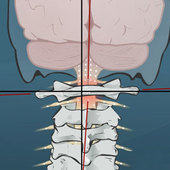When asked what symptom people with chronic headaches would prefer never to have again, the most common answer is dizziness. Dizziness and headaches are some of the most common symptoms that frequently occur together. In fact, if you were to do a quick WebMD search, you would find that dizziness and headaches are associated with 90+ different conditions ranging from mild traumatic brain injury, such as a concussion, to sunburns. So, what is the connection between these two symptoms?
Let’s start with the Neck!
The neck is a vital and complex region of the body that supports our head and allows our brain to communicate with the rest of the body. The average adult head weighs between 10-12 lbs and is balanced on a 2 oz ring of bone called the atlas (C1). While this design may seem flawed, there are approximately 44 muscles, and a near equal number of ligaments, that support our head and neck and communicate with our brain about where our body is in space.
 Neck injuries, such as whiplash injuries or chronic repetitive stress injuries (such as poor posture), can cause the joints in our neck to lock up in an abnormal position leading to a restricted range of motion and increased muscle stiffness. When our joints are not moving properly, the surrounding muscles and ligaments send incorrect information to the brain which can often lead to feelings of imbalance, unsteadiness, and light-headedness. In addition, the increased muscle stiffness can trigger referred pain and pressure that may be felt in the forehead, temples, and base of the skull. This is characteristic of the classic tension-type headache - the most common type of headache reported. Treating the underlying neck dysfunction may be as simple as correcting your posture and can dramatically reduce these symptoms.
Neck injuries, such as whiplash injuries or chronic repetitive stress injuries (such as poor posture), can cause the joints in our neck to lock up in an abnormal position leading to a restricted range of motion and increased muscle stiffness. When our joints are not moving properly, the surrounding muscles and ligaments send incorrect information to the brain which can often lead to feelings of imbalance, unsteadiness, and light-headedness. In addition, the increased muscle stiffness can trigger referred pain and pressure that may be felt in the forehead, temples, and base of the skull. This is characteristic of the classic tension-type headache - the most common type of headache reported. Treating the underlying neck dysfunction may be as simple as correcting your posture and can dramatically reduce these symptoms.
Changes in Blood Flow
Have you ever stood up too quickly and felt the initial lightheadedness and unsteadiness as blood flow is momentarily reduced to your brain? Typically, this sensation is transient. We have several built-in mechanisms to ensure our body quickly adapts to pump blood to our brain so that we do not pass out. Our brain is a very energetically expensive organ, using about 20% of our body’s metabolism to function. Changes in blood flow to our brain can occur with postural changes, dehydration, or hypertension, and it may be associated with certain types of headaches, such as migraines.
Migraines are a severe type of headache that may be associated with a host of unusual symptoms including nausea, numbness, visual changes, and dizziness. While it is not fully understood what specifically happens in the body to cause a migraine, one theory looks at changes in hormones and neurotransmitters that may trigger constriction of the blood vessels in the upper neck and brain resulting in the diverse symptoms characteristic of a migraine. For example, when this constriction occurs in blood vessels near structures associated with the inner ear, it can trigger sensations of spinning, imbalance, nausea, and vomiting. In fact, there has been an associated increased risk for young people who experience migraines and the future development of benign paroxysmal positional vertigo (BPPV), the most common cause of episodic dizziness.
 In addition, having an underlying neck injury can predispose a person to be more sensitive to certain migraine triggers such as weather changes. The upper neck acts like a bottlecap that allows fluid to flow to and from the head and body. An injury to this area can constrict this fluid flow, resulting in a sensation of increased pressure in the head. For some people, this may be associated with an increased risk of developing a migraine.
In addition, having an underlying neck injury can predispose a person to be more sensitive to certain migraine triggers such as weather changes. The upper neck acts like a bottlecap that allows fluid to flow to and from the head and body. An injury to this area can constrict this fluid flow, resulting in a sensation of increased pressure in the head. For some people, this may be associated with an increased risk of developing a migraine.
While these are some of the less talked about factors contributing to dizziness and headaches, lifestyle is another important consideration to keep in mind and includes the roles of sleep, diet, and stress management. In some instances, there may be a simple solution such as postural correction or a specific exercise; in other cases, taking a holistic lifestyle approach is required to control, reduce, and prevent episodes of dizziness and headaches. Our team of trained NUCCA practitioners are fully equipped and eager to help you uncover the root of your dizziness and headaches and get you back on your feet doing the activities that you love!
References:
https://www.ncbi.nlm.nih.gov/pmc/articles/PMC4491067/

Dr. Michelle Speranza
NUCCA Chiropractor
The Vital Posture™ Clinic
Calgary, Canada



